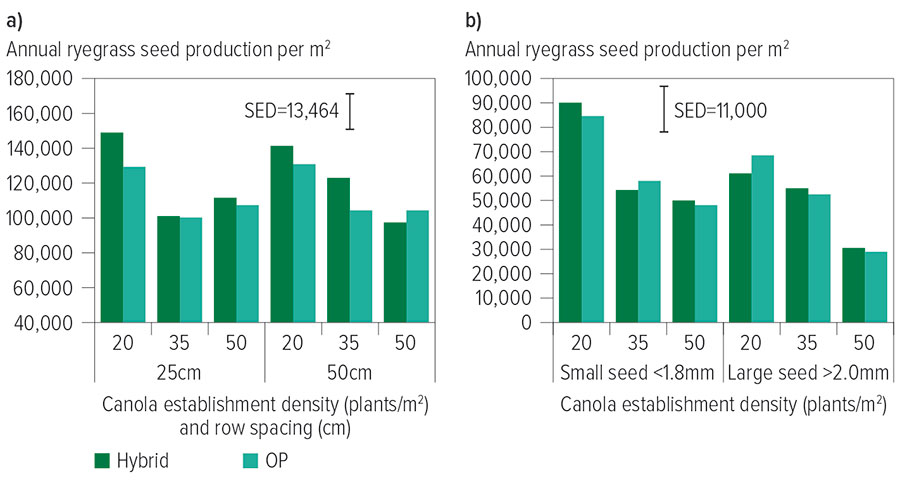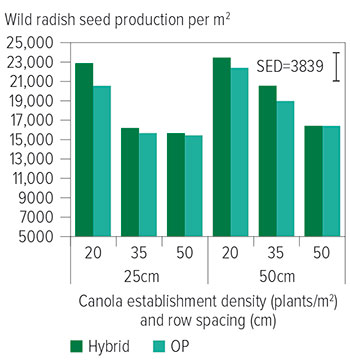Key points
- Canola yield can be significantly reduced when competing against weeds
- Canola competitiveness against weeds can be improved by reducing row spacing, increasing canola seeding rate and using larger seed sizes
- When using wider row spacing, increasing canola density is very important
- Hybrid canola varieties offer vigour advantages; however, the seeding rate should not be reduced
Canola is often thought to be a very competitive crop due to its size at harvest, but it is an uncompetitive crop early in its growth due to its small seed size and sparse establishment density.
Allowing weeds to get a foothold contributes to poor establishment and significant yield losses. As there are several weeds resistant to herbicides commonly used in canola, alternative weed management methods are needed.
With GRDC investment, the Australian Herbicide Resistance Initiative (AHRI) conducted trials over three years across the Western Australian grainbelt to see how establishment decisions could improve the competitiveness of canola against its main weed opponents: annual ryegrass and wild radish.
Competitiveness is enhanced when crops are established in a way that uses up all the solar, moisture and space resources so little is left for the weed.
Increasing crop competitiveness against weeds is also vital in reducing the weed seedbank in the soil and the selection for herbicide resistance.
To assess how canola’s competitiveness could be improved against weeds, AHRI planted 16 field trials and assessed annual ryegrass and wild radish seed production under various treatments.
A number of options to improve canola competitiveness were tested, such as pollination type – high-vigour hybrid versus open-pollinated (OP) varieties – canola seed size, canola seeding rate and row spacing.
Trials compared the effect of canola seeding rate (establishment density 20, 35 and 50 plants per square metre), row spacing (25 or 50 centimetres), hybrid and OP varieties, and seed size on annual ryegrass seed production.
To assess the effectiveness of crop competition on weed seed production, half the trial had no herbicides applied after seeding. The other half was maintained weed-free to see how the establishment densities and distributions affected canola yield and quality. Having both the weedy and weed-free treatments also allowed researchers to calculate the yield loss from weeds in every treatment.
Competing with annual ryegrass
Results from the trial showed that increasing canola seeding rate was highly effective at reducing annual ryegrass seed production.
There was also an interaction between the effect of canola seeding rate and row spacing, with narrow spacing treatments (25cm) only requiring 35 plants/m2 to greatly decrease annual ryegrass seed production (Figure 1a) in both the hybrid and OP varieties. This is in keeping with the optimum economic plant density when considering the cost of seed as determined by other GRDC investments.
Figure 1: Effect of canola variety (open-pollinated vs hybrid), establishment density, row spacing (a) and seed size (b) on annual ryegrass seed production in the absence of herbicides. Bars are Standard Error of the Difference (SED).

Source: UWA
At the wider, 50cm row spacing, the highest establishment rate of 50 plants/m2 was required for the OP variety to reduce ryegrass seed production, whereas the hybrid was still able to reduce annual ryegrass seed production at the lower density of 35 plants/m2 due to its increased early vigour.
As the row spacing widened, a corresponding increase in the minimum canola seeding rate was important to maintain low ryegrass seed production.
Larger canola seed size was also found to be important at reducing ryegrass seed production, confirming previous studies in which larger seeds were shown to increase plant vigour, resulting in higher yields.
The treatments, including larger canola seed sizes, were able to establish a dense canopy earlier, which shaded later-germinating annual ryegrass and suppressed weed set (Figure 1b).
It was found that increasing canola density and/or using narrower row spacing did not reduce canola yield while reducing weed seed production.
The use of the more-competitive hybrid varieties and increasing canola seed size was found to increase canola yield within both the herbicide and non-herbicide treatments.
Competing with wild radish
Wild radish and canola plants are very similar in growth and plant architecture, so using a competitive canola to control radish is a real contest – but it can be done.
Increasing canola seeding rate was found to be highly effective at reducing wild radish seed production. At the narrow row spacing of 25cm, a canola establishment of 35 plants/m2 was sufficient to reduce wild radish seed production, while at the wider, 50cm row spacing, 50 plants/m2 was required for both OP or hybrid varieties (Figure 2).
Figure 2: The effect of canola variety (open-pollinated vs hybrid), establishment density and row spacing on wild radish seed production in the absence of herbicides.

Souce: UWA
Wild radish seed production was further reduced when larger canola seed sizes were used to increase competition. Narrow row spacing, effective establishment densities and the use of larger seed sizes all increased the rate of canopy closure and took up more space.
Like canola, wild radish requires space to maximise its yield. When the canola crop establishes a dense canopy, late-emerging wild radish plants are outcompeted for light and space, reducing their seed production.
It was also found that increasing canola seeding rate from 20 to 50 plants/m2 did not reduce canola yield. This study also found that widening the row spacing to 50cm consistently resulted in higher canola yields, which need to be taken into account when making seeding decisions.
The effect of these treatments on profitability is being assessed; however, it is clear that more-informed decisions around canola estabishment can help to reduce herbicide application and, in turn, improve weed control outcomes.
Competitive crops are part of a profitable farming system, while also being an important tool in the weed management kit bag. However, other factors such as herbicide rotation and harvest weed seed control not only play an important role to maximise canola profitability but also in the fight to reduce herbicide-resistant weeds.
More information: Dr Mike Ashworth, 08 6488 7872, mike.ashworth@uwa.edu.au

























































